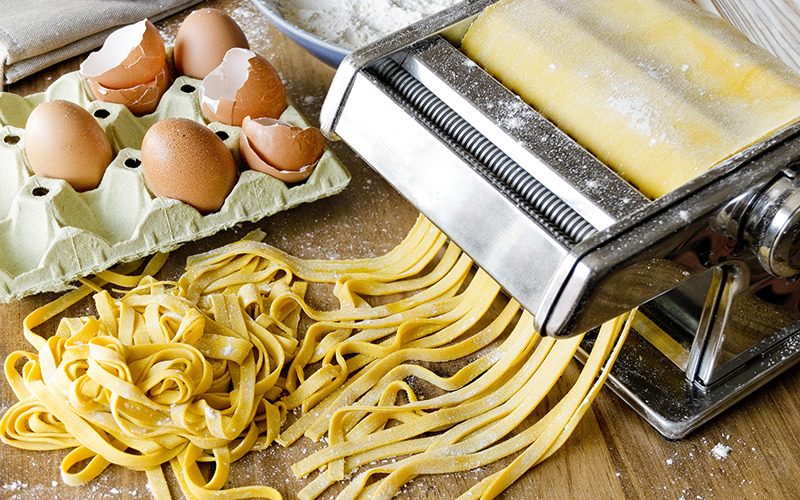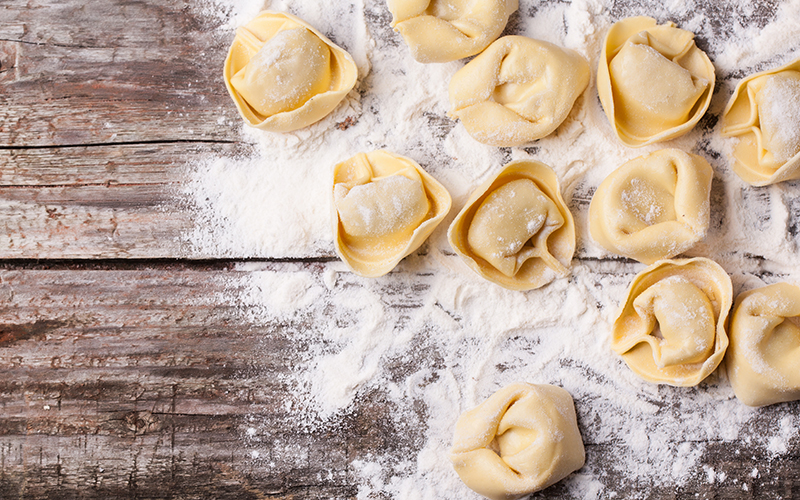Sick of the same old store-bought spaghetti? Hutchinson Shores Resort and Spa’s executive chef spills his secrets on how to make a homemade pasta that’ll make any Italian grandmother proud.
If you have a true passion for pasta, there’s no better where you can see this Italian-in-origin art form being brought to life than in Drift Kitchen + Bar, the on-site restaurant of Hutchinson Shores Resort & Spa. That’s because, just around the corner from the bar, you’ll find a 200-square-foot glass-walled “pastificio.” Essentially, it’s a pasta studio, where diners can watch chefs knead, crank, cut, and shape pasta of all kinds upon a butcher-block table before it is hung out to dry on wooden racks and cooked fresh to star in one of the many dishes: rigatoni bolognese, roasted chicken penne, bucatini carbonara – to name a few. Sure, it’s much more painstaking than opening a blue box and boiling water, but the end results are far superior and flavorful. See for yourself, by applying these homemade pasta tips in your own kitchen from pasta pro and Hutchinson Shores Resort & Spa Executive Chef Michael Vogler.
Pick Your Ingredients Carefully

Image Courtesy Opal Collection / Opal Unpacked
It’s easy to overlook this step. Flour is flour, right? Vogler says otherwise: “We use Italian ‘00’ flour because it gives us authentic taste and flavor. The heavy extraction of the bran and the germ from the flour creates really soft white flour, which is perfect for pasta making.” He also opts for pasteurized whole eggs, as well as the finest cold-pressed extra virgin olive oil as important components of homemade pasta.
Pay Attention to Your Dough

Image Courtesy Opal Collection / Opal Unpacked
Every time you make pasta, no matter the recipe, it’ll be different because of the flour. The flour could be dryer than the recipe may call for. So, make sure the dough is hydrated when you’re kneading it. If you knead it for less than 15 minutes, you’re probably not working the dough enough. “If it starts feeling dry, you’ll know you kneaded too much. You don’t want it so sticky so that it sticks to your fingers. You want to be able to pinch it and make sure there’s enough water in the dough,” Volger says. “I’ll make the pasta the day before, wrap it in plastic, put it in the fridge, then pull it out the next day. It’s easier to handle after it’s chilled, and it’s just a better product,” Volger adds. “Some people want to make the pasta right away and can’t wait.”
Invest in a Crank Machine

Image Courtesy Opal Collection / Opal Unpacked
While some pasta makers are diehard handmade, roll-it-out-with-a-pin people, you can’t go wrong with a crank machine. At less than $50, it’s worth the cost after only a few uses. You can also add attachments, like a dial to turn to make the pasta thinner until it’s the right consistency, or one of the many cutters available to give you a specific pasta shape.
Remember to Use a Binder for Fillings

Image Courtesy Opal Collection / Opal Unpacked
Be careful if you use fillings, like in ravioli. If you use just spinach or raw vegetables, it’ll cook, but it won’t be the right texture inside. Homogenous fillings should have some kind of binder, like egg, breadcrumbs, or cheese. “Raw ingredients like vegetables will bleed out. They turn into a leaky bag of juice. If you want something like spinach, cook it ahead of time and then mix it with a binder, such as ricotta cheese,” Volger says.
Don’t Be Afraid to Add Color or Flavor
For those who have the basics down and want to experiment with something different, try adding some color or flavor to your pasta. For example, try incorporating spinach or saffron into the dough. You can play with the texture, too: “There are things you can do like making ear-shaped pasta by hand, where you roll it into a tube, then cut it into small pieces and form it with your fingers. Actually, if you roll the pasta into a rope, cut it into half-inch pieces, then put it against the fine parts of a cheese grater, it gives you little ridges,” Volger suggests. These methods may be a little time consuming, but are a fun way to challenge yourself and mix up your pasta-making process.
Article originally published on Opal Unpacked






